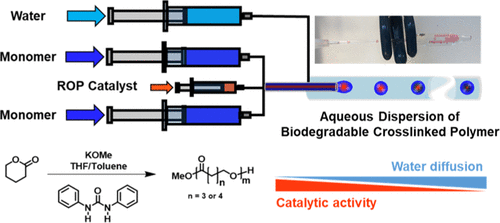当前位置:
X-MOL 学术
›
Macromolecules
›
论文详情
Our official English website, www.x-mol.net, welcomes your
feedback! (Note: you will need to create a separate account there.)
Ring-Opening Polymerization of Cyclic Esters in an Aqueous Dispersion
Macromolecules ( IF 5.1 ) Pub Date : 2020-09-09 , DOI: 10.1021/acs.macromol.0c01300 Danielle D. Harrier 1 , Paul J. A. Kenis 1 , Damien Guironnet 1
Macromolecules ( IF 5.1 ) Pub Date : 2020-09-09 , DOI: 10.1021/acs.macromol.0c01300 Danielle D. Harrier 1 , Paul J. A. Kenis 1 , Damien Guironnet 1
Affiliation

|
Aqueous polymer dispersions are commodity materials produced on a multimillion-ton scale annually. Today none of these materials are biodegradable because the process by which they are made is not compatible with the synthesis of biodegradable polymers. Herein, we report a droplet microfluidic encapsulation strategy for protecting a water incompatible ring-opening polymerization (ROP) catalyst from the aqueous phase, yielding biodegradable polymer particles dispersed in water. Polymerization yields 300 μm sized particles comprised of biodegradable poly(δ-valerolactone) with molecular weights up to 19.5 kg mol–1. The success of this approach relies on simultaneous precise control of the kinetics of polymerization, the rate of mass transfer, and fluid mechanics. The power of this methodology was demonstrated by the synthesis of cross-linked polymer particles through the copolymerization of bis(ε-caprolactone-4-yl)propane and δ-valerolactone, producing cross-linked polymer particles with molecular weights reaching 65.3 kg mol–1. Overall, this encapsulation technique opens the door for the synthesis of biodegradable polymer latex and processable, biodegradable elastomers.
中文翻译:

水性分散液中环状酯的开环聚合
聚合物水分散体是每年生产数百万吨规模的商品材料。今天,这些材料都不是可生物降解的,因为它们的制备方法与可生物降解的聚合物的合成不兼容。本文中,我们报告了一种微滴微滴封装策略,用于保护水不相容的开环聚合(ROP)催化剂免受水相的影响,从而产生分散在水中的可生物降解的聚合物颗粒。聚合产生300μm大小的颗粒,由可生物降解的聚(δ-戊内酯)组成,分子量高达19.5 kg mol –1。这种方法的成功取决于对聚合动力学,传质速率和流体力学的同时精确控制。通过双(ε-己内酯-4-基)丙烷与δ-戊内酯的共聚反应合成交联的聚合物颗粒,从而生产出分子量达到65.3 kg mol的交联的聚合物颗粒,从而证明了该方法的强大优势– 1。总的来说,这种封装技术为可生物降解的聚合物胶乳和可加工的,可生物降解的弹性体的合成打开了大门。
更新日期:2020-09-22
中文翻译:

水性分散液中环状酯的开环聚合
聚合物水分散体是每年生产数百万吨规模的商品材料。今天,这些材料都不是可生物降解的,因为它们的制备方法与可生物降解的聚合物的合成不兼容。本文中,我们报告了一种微滴微滴封装策略,用于保护水不相容的开环聚合(ROP)催化剂免受水相的影响,从而产生分散在水中的可生物降解的聚合物颗粒。聚合产生300μm大小的颗粒,由可生物降解的聚(δ-戊内酯)组成,分子量高达19.5 kg mol –1。这种方法的成功取决于对聚合动力学,传质速率和流体力学的同时精确控制。通过双(ε-己内酯-4-基)丙烷与δ-戊内酯的共聚反应合成交联的聚合物颗粒,从而生产出分子量达到65.3 kg mol的交联的聚合物颗粒,从而证明了该方法的强大优势– 1。总的来说,这种封装技术为可生物降解的聚合物胶乳和可加工的,可生物降解的弹性体的合成打开了大门。











































 京公网安备 11010802027423号
京公网安备 11010802027423号